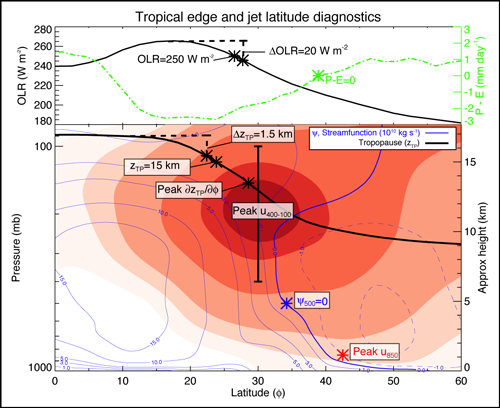The tropics are a climate zone characterized by a band of atmospheric deep convection along the equator known as the Intertropical Convergence Zone (ITCZ). This zone is surrounded by arid subtropical regions in each hemisphere. These regions are a surface manifestation of the Hadley cells, the overturning circulation pattern in the troposphere (the lowest layer of the atmosphere, where weather originates). Hadley cells are characterized by rising air in the tropics, subsiding air in the subtropics, and trade winds at the surface that move westward and toward the equator.
Although the factors controlling the properties of the Hadley cells and subtropical jet streams are understood on a basic level, significant uncertainty surrounds past changes in Earth’s atmospheric circulation and their associated climate effects.
A growing body of literature suggests that long-term changes are occurring in the boundaries of the Hadley cells.
A growing body of literature suggests that long-term changes are occurring in the boundaries of the Hadley cells. Because of the potential impact to surface climate and the hydrological cycle, these changes could have important societal and ecological consequences. These consequences, including shifts in the subtropical dry zones and associated changes in midlatitude precipitation, make it important to know what causes tropical width changes.
These issues motivated the convening of a Chapman Conference at the Eldorado Hotel in Santa Fe, N.M. The conference brought together 50 researchers from five continents with expertise spanning atmospheric and ocean dynamics, hydrology, and climate sciences. The conference was organized around four topics:
- What determines the width of the tropical belt?
- How and why has the tropical width changed in the past?
- How and why might the tropical width change in the future?
- What are the effects on the hydrologic cycle, human society, and ecosystems?

One major theme emerged from the conference discussions and spanned all four topics: The traditional “zonal mean” view of the Hadley circulation (averaged over latitude circles) stands in contrast to the more localized regional perspective needed for understanding local changes to climate, circulation, and human/ecosystem effects. Although participants were not in complete agreement on how best to interpret changes from these two perspectives, we recognized that we need better understanding of the regional and global manifestations of tropical width changes.
Does the large range of tropical width estimates reflect differences in measurement techniques, differences among data sets, or the difference between the hemispheres, seasons, and time periods studied? This topic surfaced numerous times during the meeting.
Many participants expressed a desire to better understand the relationships among the wide variety of metrics used to measure the edge of the tropics to better understand past results and communicate future findings more clearly.
We also discussed the influence of anthropogenic activity on tropical width changes, specifically climate change forced by greenhouse gas increases or stratospheric ozone depletion. Conference attendees recognized the potential for biases in the observational record affecting trend estimates.
Efforts are being organized to explore linkages between tropical width changes and other aspects of atmospheric and oceanic circulation changes.
Several presenters showed that the trends over the relatively short time frame of recent decades could be due to decadal variability caused by internal modes of climate variability such as the El Niño–Southern Oscillation and the Pacific Decadal Oscillation. Thus, the role of anthropogenic forcing may be overestimated in the observational record.
As a result of the Chapman Conference, efforts are being organized to address the outstanding issues and to explore linkages between tropical width changes and other aspects of atmospheric and oceanic circulation changes.
—Sean M. Davis, Cooperative Institute for Research in Environmental Sciences, University of Colorado/National Oceanic and Atmospheric Administration/Earth System Research Laboratory, Boulder, Colo.; email: [email protected]; Thomas Birner, Colorado State University, Fort Collins; and Dian Seidel (retired), NOAA Air Resources Laboratory, College Park, Md.
Citation: Davis, S. M., T. Birner, and D. Seidel (2016), How do climate variations affect the width of the tropics?, Eos, 97, doi:10.1029/2016EO049309. Published on 6 April 2016.
Text © 2016. The authors. CC BY-NC-ND 3.0
Except where otherwise noted, images are subject to copyright. Any reuse without express permission from the copyright owner is prohibited.

